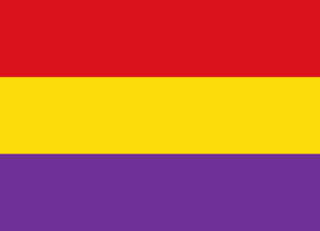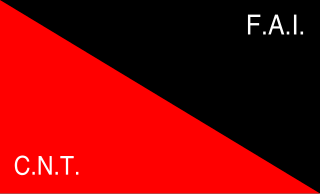
The International Brigades were military units set up by the Communist International to assist the Popular Front government of the Second Spanish Republic during the Spanish Civil War. The organization existed for two years, from 1936 until 1938. It is estimated that during the entire war, between 40,000 and 59,000 members served in the International Brigades, including 15,000 who died in combat.
Juan Guilloto León, usually referred to as Modesto or Juan Modesto, was a Republican army officer during the Spanish Civil War.

The Unified Socialist Youth was a youth organization formed in the spring of 1936 in Spain through the amalgamation of the Spanish Socialist Workers' Party (PSOE) and Communist Party of Spain (PCE) youth groups. Its leader, Santiago Carrillo, came from the Socialist youth, but had secretly joined the Communist youth prior to the merger, and the group was soon dominated by the PCE.
Enrique Líster Forján was a Spanish communist politician and military officer.

The Siege of Madrid was a two and a half year siege of the Republican controlled Spanish capital city of Madrid by the right-wing coalition Nationalist armies, during the Spanish Civil War of 1936 to 1939. The city, besieged from October 1936, fell to the Nationalist armies on 28 March 1939. Madrid was held by various forces loyal to the Spanish Republic and was besieged and subject to aerial bombardment by the rebel faction under General Francisco Franco. The Battle of Madrid in November 1936 saw the most intense fighting in and around the city when the Nationalists made their most determined attempt to take the Republican capital.

"Las Trece Rosas" is the name given in Spain to a group of thirteen young women who were executed by a Francoist firing squad just after the conclusion of the Spanish Civil War. Their execution was part of a massive execution campaign known as the "saca de agosto", which included 43 young men.

The siege of the Montaña barracks was the two-day siege which marked the initial failure of the July 1936 uprising against the Second Spanish Republic in Madrid, on 18–20 July 1936, at the start of the Spanish Civil War. The bulk of the security forces in Madrid remained loyal to the government, and supported by workers' militias, crushed the uprising.

The Spanish Republican Army was the main branch of the Armed Forces of the Second Spanish Republic between 1931 and 1939.

A mixed brigade was a tactical military formation of the Spanish Republican Army following the coup of July 1936 and the onset of the Spanish Civil War. It was the basic military unit of the Republican People's Army after its war-dictated 1936 reorganization.
The Fifth Regiment (Spanish: Quinto Regimiento, the full name Quinto Regimiento de Milicias Populares, was an elite corps loyal to the Spanish Republic at the onset of the Spanish Civil War. Made up of volunteers, the Fifth Regiment was active in the first critical phase of the war and became one of the most renowned units loyal to the Republic.

The 223rd Mixed Brigade, was a mixed brigade of the Spanish Republican Army in the Spanish Civil War. It was formed in the summer of 1937 from Coastal Defence units and had four battalions, the 889, 890, 891 and 892. This unit lasted until the end of the war.

The Madrid Defense Council was an ad-hoc governing body that ran Madrid, Spain, for about six months during the Spanish Civil War (1936–39). It was formed in November 1936 after the Spanish Republican government had fled to Valencia when General Francisco Franco's forces advanced on Madrid. It was expected that the city would fall within a few days, but the arrival of the International Brigades halted the rebel advance, and the situation settled into a stalemate. The council was dominated by communists, who had superior organization and propaganda to the other groups. Their policy was to organize the militias into regular troops and focus on defeating the enemy, rather than to undertake revolutionary activity. As time passed there was growing tension between the communists and more radical groups. The council was dissolved in April 1937 and replaced by a new city council.

Federico Melchor Fernández was a Spanish journalist and communist politician. He was one of the leaders of the Communist Youth Union of Spain. During the Spanish Civil War (1936–39) he was general director of Propaganda in the government of Juan Negrín. He became a member of the Central Committee of the Communist Party of Spain.

The 8th Mixed Brigade was a mixed brigade of the Spanish Republican Army in the Spanish Civil War. It was formed at the beginning of the Defence of Madrid in early spring 1937 with battalions of the Carabineros corps and it remained in Madrid all along the war. Its first commander was Carabineros Lt. Colonel Enrique del Castillo Bravo who was succeeded by Carabineros Commanders Emeterio Jarillo Orgaz and José Casted Sena.
Milicianas fought in the Spanish Civil War. They came from a culture with iconic fighters, and where women had been recently empowered through direct political engagement in political organizations and labor unions. The Dictatorship of Primo de Rivera saw women take more to the streets to protest and riot, though their actions were dismissed by male political leaders. The creation of the Second Spanish Republic led to an environment encouraging active political participation in broader Spanish society, and ultimately served to assist many women in their decision to head to the front, as the Government expanded rights for women, including the right to vote, divorce, go to school and stand for election.
Women in the Communist Party of Spain (PCE) in the Spanish Civil War were highly active, the most visible figure in the movement being Dolores Ibárruri, who joined in its early years. The Dictatorship of Primo de Rivera pushed the group underground, where they had to meet clandestinely around their public face, the football club Oriente FC.
Women in the Popular Front in the Spanish Civil War were part of a broad leftist coalition founded ahead of the 1936 Spanish general elections. The Second Spanish Republic represented a changing cultural and political landscape in which women's political organizations could flourish for the first time. It failed to empower women completely, as they were often locked out of governance roles and positions in political organizations. Many organizations continued to discriminate against women, as Marxist ideology did not see them as a unique group with special needs but as part of larger class grouping in which class equality needed to be prioritized.

The confederal militias were a movement of people's militia organized during the Spanish civil war by the dominant organizations of anarchism in Spain: the National Confederation of Labor (CNT) and the Iberian Anarchist Federation (FAI).
The Central Committee of Antifascist Militias of Catalonia was an administrative body created on July 21, 1936 by the president of the Government of Catalonia, Lluís Companys, under pressure by the anarcho-syndicalists of the National Confederation of Labor (CNT) and Iberian Anarchist Federation (FAI), which led the workers' struggle against the July 1936 military uprising in Barcelona.
Josep Rovira i Canals was a Catalan politician, a leader of the Workers' Party of Marxist Unification. During the Spanish Civil War he managed to send several militia units to the Aragon front, and was arrested by the republican authorities in the context of the repression against the POUM.












